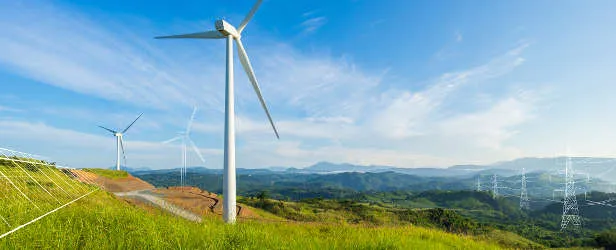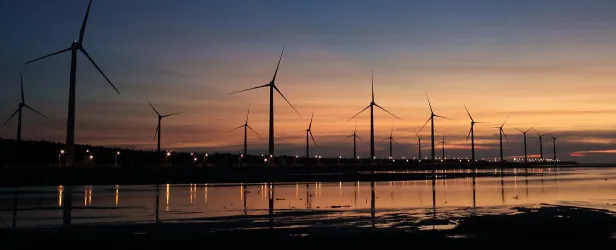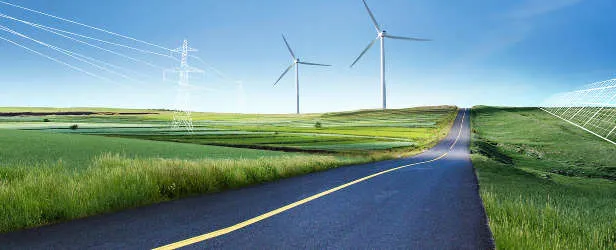January 17, 2019 | Podcast
Driving the growth of renewables
Transcript:
Transcript:
NARRATOR Welcome to the DNV Talks Energy podcast series. Electrification, rise of renewables and new technologies supported by more data and IT systems are transforming the power system. Join us each week as we discuss these changes with guests from around the industry.
Transcript:
MATHIAS STECK Welcome to a new episode of DNV Talks Energy. My guest today is Girish Tanti, co-founder and board member of Suzlon Energy. Welcome, Girish.
Transcript:
GIRISH TANTI Thank you. Thank you for having me.
Transcript:
MATHIAS STECK Girish, we want to talk about the massive build-out of renewables going forward to enable and support the energy transition and the role of wind in that; but before we get into this, it would be great if you could introduce yourself as a person and tell us a little bit about Suzlon.
Transcript:
GIRISH TANTI Yes, so I’m the co-founder of Suzlon Energy Ltd. This is a company that we incorporated in the mid-90s. Our primary initial focus was more about getting renewable penetration for the Indian energy environment, and in the 2000s, we took the company global. And since then, we have been amongst the top leading companies across the world, with a total installed base of 7 gigawatts plus, worldwide with operations across 32 countries now.
Transcript:
MATHIAS STECK Yes, this is an amazing story and I remember an anecdote of my former boss, Andrew Garrad, who taught me that somewhere in the early 1990s, your brother, towards the end, yourself, probably, came to the Bristol office those days, and I think you were in a totally different business, you were in the cotton-spinning business?
Transcript:
GIRISH TANTI That’s correct.
Transcript:
MATHIAS STECK There was a limited number of employees, but how did you come up with this vision? How did you know, at that point in time, that wind is the big thing, going forward?
Transcript:
GIRISH TANTI Yes, so, before the energy business, we were in the textile business, and primarily it was polyester yarns and synthetic yarn, and in this industry almost 30% of your cost of production comes from electricity, energy, and so, we were trying to find a solution to reduce our cost in the textile business. And while looking at various options of going into self-generation of electricity, we found that wind was a good solution because it’s modular in nature, for the size that we wanted at that point in time. And it was early-stage, it was a bit challenging at that point in time, but we started originally as an investor into wind and slowly realized that this is something with a strong future, and that’s how finally we decided that we will go full-fledged into the energy business.
Transcript:
MATHIAS STECK Right. So, we are a couple of decades later now, and if we look into the Energy Transition Outlook DNV has just launched, we see that this massive upbuild of renewables is required to lead us into an energy future which limits climate change to limits which we can adopt to; but if we look at your own history first, Suzlon has 12 gigawatts I think now in India, which is about a third of the installed capacity in the country. But if we move forward now, we see a massive build-up to come; what needs to happen with regards to manufacturing, supply chain, the grid side? What does the industry to really do this massive build-up required?
Transcript:
GIRISH TANTI So, I think there is no set of things that specifically can work for all countries, so, you need to see it by countries or by regions, because there is a history; and also it’s development growth which has happened, and the amount of investments that have happened across various countries. So, different issues prevail in different parts of the world. Just say, for example, if you take even just the ASEAN region for the conferences we are talking about today, the issues which a country like Singapore would face would be very different than maybe an issue which a country like Indonesia or Myanmar or others would face. And therefore, I think what is most critical is, first, for each country to set out a clear set of goals, an ambitious goal of switching to renewable energy. That is the first step, and I think once that is there, then, if they’re able to provide the right environment for the switch to happen, then various modules will fit in, because some countries, also the solutions could be different. In some places, solar may work better; in some places, wind may work better. But today, most importantly, you see both wind and solar have got grid parity, so, they are cost-efficient and they can compete with any other conventional power source. So, that is the level of technology development and growth that has happened for the sector.
Transcript:
MATHIAS STECK You just mentioned technology development. One thing we are also talking a lot about on these conferences is how digitalization is enabling the future energy system. With regards to wind, what would you think the impact of digitalization would be? How can we use it to be more efficient, to have better turbines and so on and so forth?
Transcript:
GIRISH TANTI Correct. So, today, if we see the wind turbines by themselves, they are pretty sophisticated with lots of digital capabilities, and they’re already, in a way, smart because they work in nature by themselves. It’s an uncontrolled environment and they have to perform in that, so, this is one kind of power plant that which stands up in mother nature and performs with various seasons, as they go by. So, it is a sophisticated device. The key thing now, in the next wave, what we have to have is that we need to get full-scale integration of renewables into the mainstream power grid completely, so, I think where the future of digitalization is going to play a significant role is in the whole power system. And how can we make smart decisions with different sources of energy? Because for all countries, no one source is going to be the solution. They have to diversify into multiple energy sources for transition to the decarbonization of their entire energy system. But it’s important that they leverage the IT technology to the fullest, so that we can make this transition in a much smarter way. And see, through time now, we are going to also see a lot of power going into the hands of consumers, so they’re going to drive the change also. So, it’s like how, today, we have the telecom industry driven by consumers; we will see the energy industry also being driven by consumers. So, there will be a shift in demand and what choices the consumer will want will drive the change also, so that will speed up things.
Transcript:
MATHIAS STECK Another factor, talking about things which change and influence the industry, is the prices have come down massively.
Transcript:
GIRISH TANTI That’s correct.
Transcript:
MATHIAS STECK When you started in this industry, there were people accusing the industry that it would be so expensive and not competitive with conventional generation, but this has switched now. In many places, renewables are cheaper than conventional generation. This is good news because it has helped the breakthrough, but it’s also challenging in that sense that finance has to become cheaper as well. And at least in many parts of the world, we had a lot of equity investors who went in and the yield rates are not attractive enough for them anymore. What do you think about this whole matter of finance and what needs to happen, that there are no other showstoppers in the build-out of wind energy coming from that direction?
Transcript:
GIRISH TANTI Yes, so, today I would say that if we just step back and see that this is probably the beginning of a new journey in the global landscape where we are seeing that the quantum of new energy being added worldwide, the share of renewables is growing significantly, at least for the new capacities. What this means is that I think overall the world is united in a way that the future has to go into decarbonization, so I don’t think there is any doubt around that area anymore. Also, I think while there are different views on climate change, I think there is a broad consensus that we need to get control over this aspect. We cannot leave it completely open. There are challenges on how to do it. So, ultimately what is happening is that, at the same time, the third point which nations are facing is that, most nations do not have enough source of energy, natural resources, to solve their energy demand in the future. So, with these all coupled, they have to make choices of what source of energy they want to liberate the most.
So, it has to be a basket of sources. Now, within that, today renewables, because of its great parity that we have today, especially for wind and solar; with that kind of thing, now money is chasing those projects, so, I do not see, in the current environment, that, in general, there is a lack of money for the projects. I think if you have good projects, there is quite a lot of money. Where the issues are coming is maybe project-specific issues or country-specific issues. Again, if you look back a little bit, it is more driven by the policy or some regulation matter. It’s more a regulatory issue than a financing issue, because if the regulatory issue is sorted out, I think technology is there and projects will happen on that ground. And I think with a massive amount of money chasing, today, renewable projects, funds are there. You just need to have the right project.
Transcript:
MATHIAS STECK I want to touch on one more aspect, and this is the Sustainable Development Goal Number Seven, providing access to clean and affordable energy to as many people as possible, or actually to everyone.
Transcript:
GIRISH TANTI Yes.
Transcript:
MATHIAS STECK And I want to go back a little bit to your region again, in India. Maybe you can share with us a little bit what approach Suzlon has taken to also integrate communities in rural areas into this journey in moving towards renewables?
Transcript:
GIRISH TANTI Yes. So, this is something at the core of what Suzlon does: taking the community along with us. And we have a separate Suzlon Foundation which focuses around the community development around the wind farms that we build. So, it starts right when we start the initial stage of wind prospecting. At that stage, we also start doing the community assessment. So, we have devised an entire social model, through which we do a proper study of the region, with the people there, and come out with a five-year plan for them, in terms of what is going to be their growth strategy, what are the key issues that they are struggling with and how can we help and work with them? And different communities have different subject areas which come up. It can be anything. Health, hygiene, electricity, medical, education, it could be anything, livelihood.
So, what we have devised is we have devised the whole social model which is a principle of three pillars. We have engage, empower and sustain.
The way it works is that, with the engagement, at the phase where we work with the local people themselves in trying to work with them to make them build their plans and prioritize issues which concerns them most for their growth.
In empowerment, what we do is that, because there are a lot of already existing programmes across India, by the government of India also, and a lot of NGOs are doing a lot of good work across the country, so, what we do is we try to put all those blocks together and build capabilities at the ground level. Because it’s not just money, it’s the capacity which is critical to make the change happen on the ground. So, we focus on developing capabilities so that the projects that are identified are then driven by the people in the communities themselves. We facilitate that process.
And then, sustain is the model where, over a period of three years max, we have to withdraw from that project and make sure that the local team or the local community is able to maintain and take care of those projects moving forward. So, we have, across the country, several social projects going across the country, and I think it’s a very integral part of Suzlon and our core value to take the community along with us and make sure that everyone benefits out of such a group.
Transcript:
MATHIAS STECK Very good, very good. Girish, we are unfortunately coming slowly already to an end to this episode, but one question I would like to ask you, since we are recording this episode at the site of the Singapore International Energy Week 2018, what is your main take-away of this conference?
Transcript:
GIRISH TANTI So, I think there are quite a few positive elements that have come through. The most important that I see is that there is an overall recognition of two or three aspects. One is that all the various ASEAN countries, together, have a common alignment that we need to decarbonize. We need to have a mix of products; no one product is going to be good enough for us. And there is limitation of resources that each one of us has, so we have to work as one team. Slowly, the unity… as I’m looking at it, the future should be that we have an energy union, if we can achieve that, because there are patches of things which can happen in one region which another region can’t. Ultimately, the consumer could benefit and people across ASEAN could benefit from that.
So, I think there is a good consensus on the need to change and make the transition. The main question that is coming is how quickly can we do it, and at what cost? And I think that’s where the pace is being set by the governments in terms of the bold targets, and I’m educating them to raise the bar and put stronger goals, rather than just incremental goals. But as a whole group, ASEAN has set a goal of achieving 23% of renewable energy [in its energy mix] by 2025, from currently a little over 9%, so, it’s a good size of increment that we are looking at. And I think what I have also been educating the members on is that, at least for wind and solar for sure, I can tell them that they have grid parity. So, if you give us a level playing field, we have the technology, the capabilities, to help you in this journey. And it has been quite successful in talking to various stakeholders at the conference.
Transcript:
MATHIAS STECK Very good. Girish, thank you very much for your highly interesting insights and for your time. This was Girish Tanti, co-founder and board member of Suzlon Energy.
Transcript:
GIRISH TANTI Thank you.
Transcript:
NARRATOR Thank you for listening to this DNV Talks Energy podcast. To hear more podcasts in the series, please visit dnvgl.com/talksenergy.


